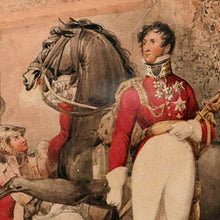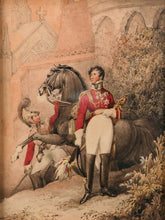His Serene Highness Prince Leopold of Saxe-Coburg, 1816
- Regular price
- £2,400
- Sale price
- £2,400
- Regular price
-
- Unit price
- /per
Adding product to your cart
Overall: 35cm (13.7in) x 29cm (11.5in)
Watercolour on paper. Full length portrait study of Prince Leopold (later first King of the Belgians) at the time of his betrothal to Princess Charlotte of Wales; in military uniform wearing the breast stars of the Royal Order of Guelph (Hanover) and St. Alexander Nevsky (Russia), with the badges of the Order of Maria Theresa (Austria), Iron Cross (Prussia) and others, reflecting his role as a senior commander in the War of the Sixth Coalition (March 1813-May 1814), by which France was defeated and Napoleon driven into his first exile on Elba. Framed and glazed. Image: 23cm (9in) x 17cm (6.8in).
Prince Leopold (1790-1865) was granted British citizenship in March 1816 shortly before his marriage in May 1816 to Princess Charlotte of Wales, then second in line to the British throne. The present watercolour by the fashionable military artist and caricaturist William Heath shows Leopold beside his charger and attended by a trooper of the Life Guards as befitting his royal status. The church in the background perhaps hints at his forthcoming marriage ceremony which actually took place a Carlton House, home of his father-in-law, the Prince Regent (afterwards George IV).
Read more
Largely unknown to the public at that time, Leopold’s portrait was published by Ackermann and others following his investiture as a Knight of the Garter in June 1816. Biographical sketches published in the newspapers at the time recounted his military service as a Prince of the Confederation of the Rhine in Germany’s Wars of Liberation (1813-14). When French troops occupied the Duchy of Saxe-Coburg in 1806, Leopold went to Paris where he became part of the Imperial Court of Napoleon. Napoleon offered him the position of adjutant, but Leopold refused. Instead, he went to Russia and campaigned against Napoleon as a cavalry general, He distinguished himself at the Battle of Kulm in August 1813 at the head of his cuirassier division. In 1814 campaign he was present at the battles of Lützen, Bautzen and Leipzig
He proved a calming influence on the tempestuous Princess Charlotte Augusta (1796–1817), heir to the Prince of Wales. Charlotte and Leopold were formally engaged in March 1816, but their slow-burning romance began much earlier, in the summer of 1814 when they first met by chance at a London hotel when Charlotte was trying to avoid a meeting with her intended ‘Silly Billy’ Prince of Orange. Leopold was created Duke of Kendal and continued to live in England after Charlotte's tragically early death in childbirth in November 1817. He is best known as the first King of the Belgians, which throne he accepted after declining the Greek throne the previous year, in June 1831. As the favourite uncle and adviser of Queen Victoria, he was able to engineer in 1840 her marriage to his nephew, Prince Albert. His high intelligence and wisdom were valued by many sovereigns and statesmen. By his second marriage, in August 1832 to Louise-Marie of Orléans, daughter of the French King Louis Philippe, he ensured his family's succession to the Belgian throne.
William Heath (1794-1834) was born in Northumberland and was producing work by the age of fourteen. Despite an apparent absence of any formal training, he was well read and appears to have moved with ease in Regency London’s fashionable set. His early works often dealt with military scenes, and included the colour plates for the ‘Martial Achievements of Great Britain and Her Allies; From 1799 to 1815’. He also worked with publisher Daniel Orme in producing the designs for the paper roundels featuring Wellington’s victories. Later caricatures portrayed Wellington the prime minister in a less flatteringly but equally popular light as a lobster, dog and jackass. In about 1820 he took up residence near Hannah Humphrey's well known print shop at 27 St James's Street, through which he published numerous social satires. Ladies fashion, smoking, drinking, and gambling were the recurring themes that might help explain the accusation that the 29-year-old Heath was a person of extraordinary talents marred by careless habits, drinking, debts, and unpunctuality. Heath’s talents further extend to the production and publication of military costume watercolours and plates - ‘Military Costume of the British Cavalry’, (c1827) and ‘Costume of the British Army' (1828) - which reflected a more serious side to his art.






